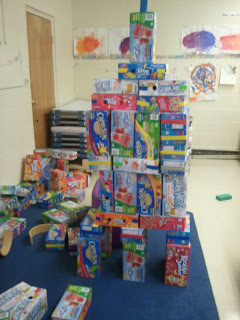There are a lot of great children's books out there about being thankful and we we read quite a few. (:

The first thing I ask the class is what does thankful mean. I get lots of guesses such as "When we say thank you" and "Thanks for giving me something". I like to take their answers and show them how they are correct by asking them open ended questions like "What are some things you say 'thank you' for"? or "What is something someone might give you"?
There is a cute book called Thanks for Thanksgiving by Julie Markes. It talks about lots of things big and small to be thankful for like turkey on the table, warm cozy cuddles, dress up clothes and big red hats.
Often times preschoolers think of toys and other tangible things when asked what they are thankful for. I like to expand their thinking to include people, actions and ideas.
Every day for the month of November we go around the circle and each one of us says something we are thankful for. I try to encourage them to think of something different each day.
This activity came about the middle of the month. I made the turkey the kids provided the leaves and the words. We made lots of feathers for them to cut out and they were allowed to cut as many as they wanted with everyone required to make at least one.
Great practice cutting on curved lines as well. We used lots of fall colored scrapbook and construction paper. The thicker and thinner papers also helped those who were having trouble getting their scissors to work the way they wanted them to. (:

















































